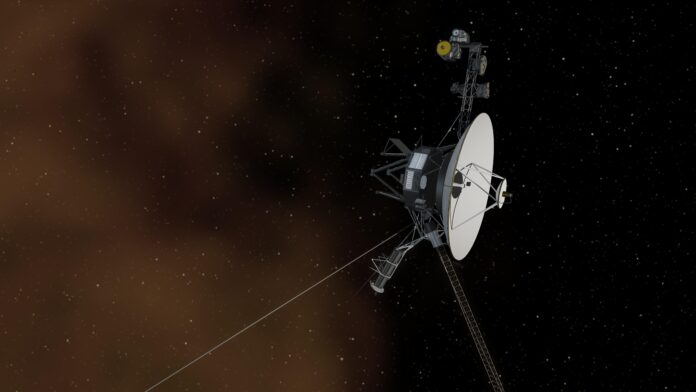As it turns out, spacecraft aren’t immune to age. In November 2023, NASA’s 46-year-old Voyager 1 spacecraft started sending a stream of nonsense to Earth, spewing out signals without any morsel of meaning. Members of the Voyager 1 mission team are rushing to resolve the issue in the aging spacecraft and are relatively optimistic after receiving a more meaningful response from the spacecraft this month.
But the ongoing breakdown in communication casts doubts on the durability of the probe and about why its systems are so prone to problems — a product, it seems, of the passage of time.
Read More: The Best of Voyager: The Longest-Running Space Mission in History
What Went Wrong with Voyager 1?
Sent into space in 1977 as part of NASA’s Voyager mission, the Voyager 1 spacecraft has traveled more than 15 billion miles through space. Throughout its travels, the spacecraft has collected information about its surroundings and its status while drifting deeper and deeper into the universe, compiling insights on the outer solar system and the space beyond the outer solar system alongside its twin, the Voyager 2 spacecraft.
The probe has had its fair share of bugs throughout the course of its trip, with one of its biggest blips beginning in November. Though the spacecraft continues to receive and respect the commands of the Voyager 1 mission team, its communication system started to fail at around that time, meaning the spacecraft cannot send meaningful signals of its own. Instead, it’s stuck returning a repeating sequence of ones and zeros, rather than its typical output of important insights condensed in convenient bundles of binary code.
As of now, the problem seems to persist, interrupting Voyager 1’s interstellar investigation. But this isn’t the only problem that’s troubled the probe. In fact, after almost fifty years of flight, Voyager 1 is increasingly showing signs of its age.
Read More: Voyager: The Man Behind the Mission
Why Is Voyager 1 Prone to Problems?
Initially intended to study Jupiter and Saturn, Voyager 1 and Voyager 2 were built to survive only five years of flight. But as their flybys of the two planets came to a close and as their trajectories forged further and further into space, it seemed a shame to cut their travels short. In time, their two-planet mission transformed into a four-planet mission, and their four-planet mission transformed into an interstellar mission, as the probes became the first spacecraft to shoot into the space between stars, in 2012 and 2018 respectively.
Since then, though, Voyager 1’s smooth sailing has become bumpier and bumpier, possibly a product of age. In 2017, for instance, the probe’s primary thrusters started to struggle, pushing the Voyager 1 team to switch to its secondary thrusters to maintain its ability to align itself for communication. And in 2022, Voyager 1’s attitude articulation and control system (AACS) met with a malfunction of its own, reducing the spacecraft’s messages to meaningless nonsense, a lot like the issue that started in November.
Aside from these issues, it’s the diminishing power supplies of the aging spacecraft that pose the biggest problems: As their power diminishes, scientists are slowly switching off some of their scientific instruments in an attempt to save others. It’s a strategic move, as mission team members attempt to get as much information out of the probes as possible, though issues, including the ongoing Voyager 1 glitch, only get in the way of that goal.
Read More: Voyager: What’s Next for NASA’s Interstellar Probes?
What Will Fix Voyager 1?
Identifying the issue in the spacecraft’s computers, the Voyager 1 mission team concluded that the current conundrum arose from a “corrupted section” in the software of one of Voyager 1’s communication systems, called the flight data subsystem (FDS). This subsystem bundles the information collected by the probe before it is beamed back to the mission team.
In December, the mission team restarted the FDS, though the restart failed to return the subsystem to its functional state. In the aftermath of the attempt, the team then decided to send a command called a “poke” to the probe on March 1. The poke was cautiously considered and planned to push the corrupted subsystem to work around its corruption.
A response was received on March 3, not nonsense, but still difficult to discern. The delay in the response was anticipated — it takes 22.5 hours for signals to reach the probe and another 22.5 hours for signals to reach the mission team — but the response was cryptic. It wasn’t until March 10 that the mission team members determined the response carried a readout of the FDS memory, including its initial instructions as well as its altered code, whether altered by command or by the status of the spacecraft.
By comparing the readout to those received before the issue began, it is possible that the team will identify the source of the problem, as well as its solution. But that “will take time,” according to a NASA press release — a particularly precious resource for the aging probe.
Read More: 5 NASA Spacecraft That Are Leaving Our Solar System for Good
Article Sources
Our writers at Discovermagazine.com use peer-reviewed studies and high quality sources for our articles, and our editors review for scientific accuracy and editorial standards. Review the sources used below for this article:
Source : Discovermagazine






